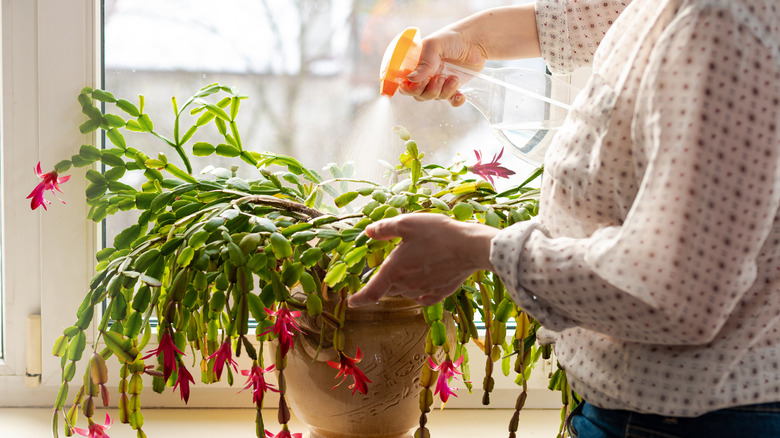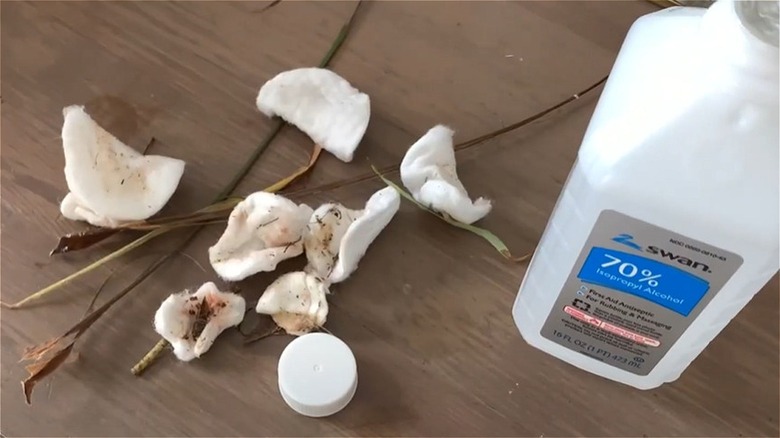The Simplest Way To Banish Mealybugs From Your Christmas Cactus
Picture a Christmas cactus' (Schlumbergera) bountiful, vibrant blossoms hanging gracefully over stunning green arching branches, bringing unexpected beauty in even the chilliest of winter months. These eye-catching cacti are named so for their ability to brighten indoor spaces around the holiday season with a magnificent array of red, pink, or white flowers. But what if the very merry companion was to be ambushed by a swarm of pesky mealybugs? A ghastly white, cotton-like fluff on your beloved plant may signify the presence of these annoying invaders. However, there's no need to panic and reach for that synthetic insecticide. Instead, a common household staple could be your knight in shining armor when getting rid of mealybugs with household ingredients. Our hero here is rubbing alcohol.
Unlike systemic insecticides that must be absorbed by the plant's foliage, rubbing alcohol strikes discreetly but decisively. In a direct, no-nonsense approach, it dissolves the mealybug's waxy protective coating, leaving it exposed and vulnerable. Then, with the speed of a disgruntled wind, the rubbing alcohol evaporates, dehydrating and ultimately killing these unwelcome plant invaders. This is significantly swift, primarily because mealybugs are soft-bodied creatures. Rubbing alcohol offers an affordable, safer option to synthetic insecticides, one that's readily available at home or can be purchased for a cheap price. For instance, you can secure a 32-fluid-ounce bottle of Equate 70% Isopropyl Alcohol from Walmart for less than $3 — a thrifty rescue that your Christmas cactus will cherish.
Using rubbing alcohol for Christmas cactus mealybugs
Per the University of California, you can engage the battle against Christmas cactus mealybugs with the power of rubbing alcohol in one of two ways: dabbing the insects directly using cotton swabs or makeup pads soaked in alcohol, or spraying a homemade insecticide. To complete the first method, with careful, surgical precision, start by identifying the infected areas on your Christmas cactus — you're looking for clusters of fluffy, cotton-like bugs. Pop the cap off your 70% rubbing alcohol bottle and moisten your cotton swab or makeup pad. Remember, your skin may have a rough encounter with the alcohol, causing grievous irritation or unwelcome dryness. Protective gloves play the unsung heroes in this saga. Now, with the grace of a seasoned artist, gently dab the cotton swab directly onto the visible mealybugs. Keep going until you've treated all visible mealybugs.
Now, if the infestation turns out to be more of a bug nation and less of a small gathering, you'll need heavier artillery. At this point, dabbing just won't cut it. Time to switch to a sprayer of rubbing alcohol solution. Check for severe areas of infestation and, in a plant-friendly sprayer, whip up a diluted rubbing alcohol solution using a water-to-70% alcohol ratio of 3:1. Ready your aim and spray this potent concoction generously onto the entire plant. Special attention should be paid to the underside of leaves — your enemy's preferred hangout spots.
Downsides and caveats for this mealybug control hack
In your determination to prevent your Christmas cactus from dying, it's easy to ignore rubbing alcohol's potential side effects. The solution, if not carefully diluted, could dehydrate or damage the very plant you're trying to protect, leaving you grappling with curled, discolored, or even withered leaves. Testing a small, unnoticeable area with the alcohol solution and keeping an eye on it for a full day is recommended.
Remember, your physical well-being is on the line as well, since the rubbing alcohol's fumes could give you a dose of irritation, dizziness, or even confusion. Thus, ensure you are in a properly-ventilated space when preparing or using the solution. Still, a tiny bit of carelessness could have you grappling with alcohol mist or splashes in your eyes, an encounter nothing short of distressing, so be cautious. While at it, you don't want flames and heat sources (think candles, gas stoves, matches) having a face-off with vapors from the highly-flammable rubbing alcohol, as that's a disaster waiting to happen.
Further, the job might not be over after one treatment. As soon as the rubbing alcohol dries up, it's no longer the superhero against mealybugs. Any eggs unharmed by the direct contact may hatch and launch a counterattack, plunging you back into battle mode. If the mealybug infestation persists despite all your efforts and multiple treatments, enlist help from a professional pest control service. After all, every plant deserves a fighting chance.


